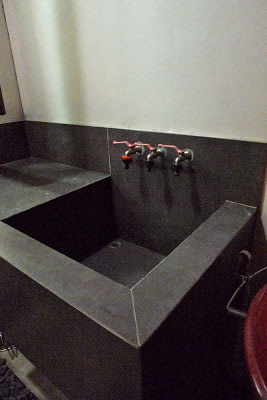 |
| The tiny pond with "floating" steps. |
If houses could speak, what stories would they tell? In many ways, we can think of home-building as story-telling; of architects as authors; and of elements of design as pathways to the homeowner's inner mind. So when I found out we were invited to dinner to the home of our friend, Architect Avery Go and his wife Kit, I was excited to go! I so looked forward to great conversations, with the proud new homeowners, and the home they built... yes, I planned to converse with the house, I was ready to listen to what it had to say. And the house seemed to sense my desire to communicate - it shouted at me as our car turned the corner into their street..."psssst!!!! I am here", it said. You see, Avery seemed to be playing a trick on his guests. His house did not have a number displayed outside, as though on purpose. And our driver was about to pass it by... but it called out to me. So I asked him to stop. "That's the house" I said. And so it was.
 |
| Air-con-water catch basin, with bamboo dipper. |
Now this house has many things to say, but for this blog post, I will stick to sharing that one particular message that was oh so loud and clear : SAVE WATER!!, it said repeatedly. It was a message whispered in the walls. Literally. All around, where ever an air-conditioning unit was installed, so too was a drain pipe built into the wall, artfully designed: accentuated with a bamboo spout, and accompanied by a huge ceramic jar serving as a catch basin. To complete the look, a bamboo dipper rested on the rim of the jar, ready for some scooping action to wet the plants and fill the pond with water collected from air-conditioners. It reminded me of beach resorts with indigenous-inspired design - like Pearl Farm in Davao, or Friday's Boracay. I was momentarily transported. Never before, has aircon waste made me think of beach vacations... that is, until the visit to Avery's house.
 |
| The sink-with-three-faucets. |
Towards the back, behind the kitchen, in the utility area, another quiet corner had it's own story to whisper. The Sink-With-Three-Faucets was no ordinary sink. It was profoundly linked to the entire house, from top to bottom. Nope, having three faucets did NOT strike me as redundant. It was brilliant! SAVE WATER! the three faucets seemed to say in chorus. Faucet one was the usual faucet, like everyone else's. It is water that is linked to a service provider, and paid for each month. Faucet number two...and here's where I find much inspiration, is linked to the roof's drain pipes and gutter system which flow into a rain catch basin and reservoir. How wonderful it is to use water provided by mother nature! For free! And then there's faucet number three... which is linked directly to an al fresco over-sized tub on a deck just above the Sink-With-Three-Faucets.
 |
| The custom-built, concealed, outdoor tub. |
Now this outdoor tub is a lovely idea - outdoors, but concealed with vegetation - it offers both freedom to be out in the open, and privacy from prying eyes. It is a favorite hang-out for Avery and Kit's little kids. And they have organic soap on hand, the certified-environment-friendly variety, for when they want to use the tub for a good soak. Seeing the tub reminded me again of resorts with signature outdoor baths - places like The Farm at San Benito... and Mandala Spa and Villas in Boracay. I usually think of huge tubs as wasteful, but not in this house. After being used, the water is collected, and drains into the third faucet, and gets used for cleaning the floors and tiles of the patio, and the slats of the outdoor deck, and even to water plants, or fill the pond. Now this lovely little pond, is worth another chapter! It is almost a self-sustaining little ecosystem in itself, with a thriving population of frogs and fish. He pointed to a lily pad where an adorable little green frog was sitting regally like true blue royalty. It was making this captivating sound, a mating call perhaps? If I wasn't already married, I would have given it a kiss! But I already have my prince, so I could no longer be tempted by an enchanting frog.
 |
| Avery, showing us his pond's resident creatures. |
I loved the many ways in which this house tells the story of the need to conserve water. The objective of harvesting water is integral to the house's design, and is incorporated into everything, from the roof's gutter system, to the water pipes embedded in the walls, to the pond running along the length of the house - everywhere, water is collected, and reused, beautifully. The execution is clean, and subtle - whispered elegantly - and not shouted out from rooftops, like the usual oversized, super-shiny water tanks found in many Filipino homes.
Now, I finish this post without having really shown you the lovely house of Avery and Kit - but that's really their story to tell. I don't feel guilty sharing their great ideas about water conservation though - for if we all find inspiration from the example set by their home, and if we all find ways to catch more rain water for our daily use, instead of sucking dry Manila's supply of fresh water through groundwater pumping - if we all listened to the story their house told, and learned a lesson... it will all be for a good cause. If a house is a window into the homeowner's mind, let me tell you the conclusion I arrived at after seeing the architect's home: Avery Go is green-minded. Indeed.
Thanks Avery and Kit! We had a great time!



















